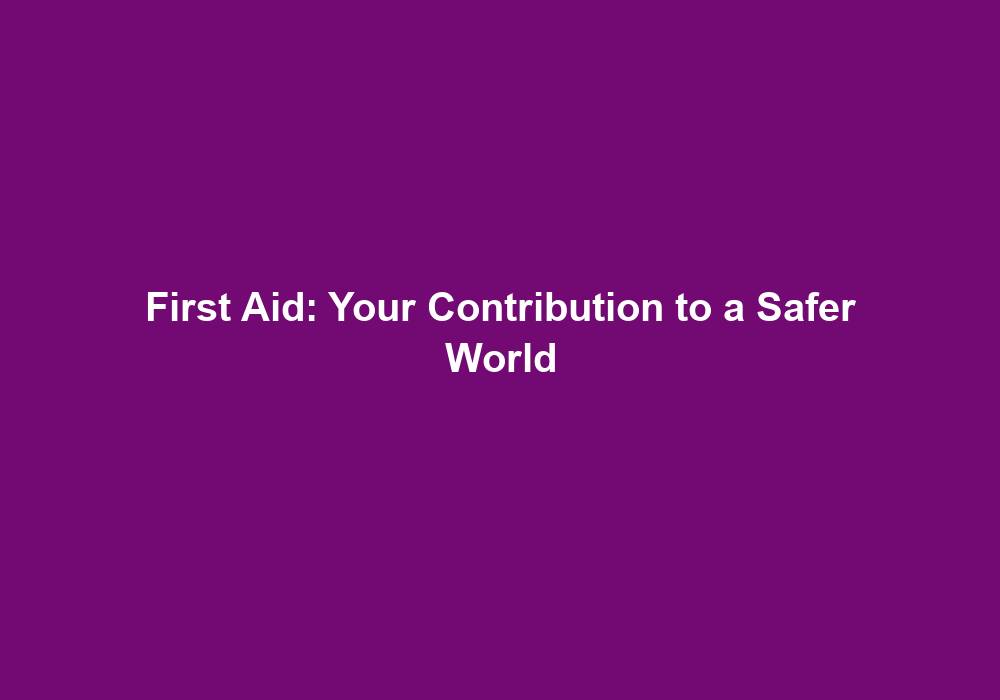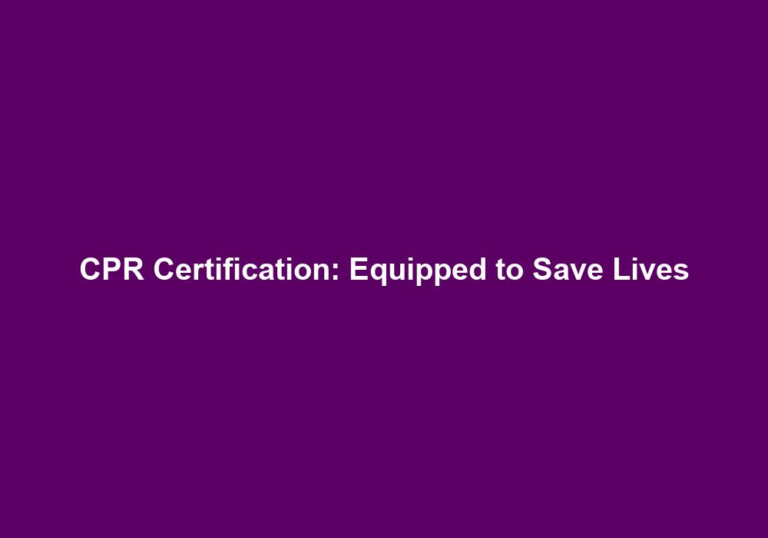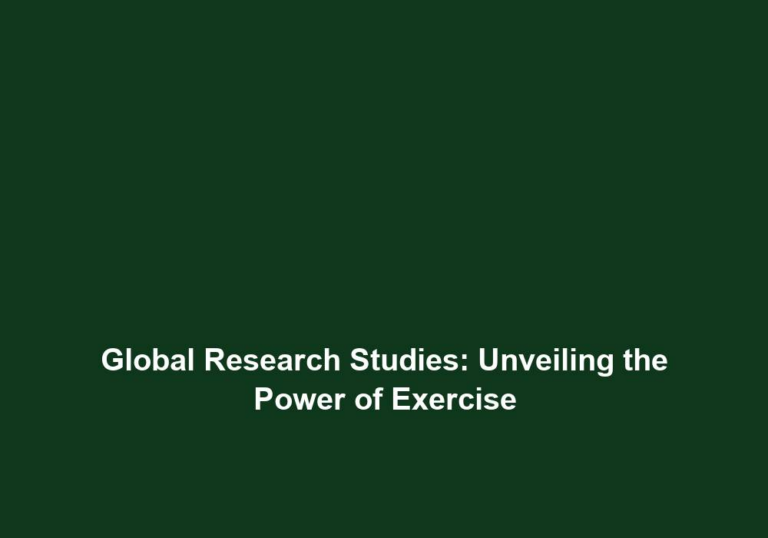First Aid: Your Contribution to a Safer World
First aid is a crucial skill that everyone should possess. In emergency situations, knowing how to administer first aid can make a significant difference in saving lives and minimizing further harm. By learning and practicing first aid techniques, you can contribute to creating a safer world for everyone.
The Importance of First Aid Training
-
Immediate Response: Accidents and emergencies can happen anytime, anywhere. When someone is injured or in distress, immediate action is vital. Knowing first aid enables you to respond promptly and appropriately, providing immediate relief and increasing the chances of a positive outcome.
- Quick response: With first aid training, you will be able to assess the situation swiftly and provide the necessary assistance without wasting precious time. This immediate response can prevent the condition from worsening and save lives.
- Understanding emergency protocols: First aid training equips you with the knowledge of how to handle different emergency situations. You will learn about the appropriate steps to take, such as performing CPR, controlling bleeding, or providing basic wound care. This knowledge empowers you to act effectively in critical moments.
-
Primary Stabilization: First aid aims to stabilize the injured or ill person until professional medical help arrives. By applying first aid techniques, you can prevent the condition from worsening and potentially save someone’s life.
- Basic life support: First aid training includes learning cardiopulmonary resuscitation (CPR), a life-saving technique used when someone’s breathing or heartbeat has stopped. By performing chest compressions and rescue breaths, you can maintain blood circulation and oxygen supply to vital organs until medical professionals arrive.
- Immobilization techniques: In cases of fractures or sprains, knowing how to provide immediate immobilization using splints or ice packs helps reduce pain and prevent further injury. These techniques are crucial to minimizing the risk of complications.
-
Empowerment: Having knowledge and confidence in first aid empowers individuals to take control of emergency situations. Instead of feeling helpless, you can step forward, assess the situation, and provide effective assistance.
- Confidence to act: With first aid training, you gain the confidence to take immediate action during emergencies. You will be equipped with the skills to assess the situation, make informed decisions, and provide appropriate care.
- Leadership in emergencies: By being trained in first aid, you become a leader in emergency situations. You can guide others, delegate tasks, and coordinate efforts to ensure a more organized and effective response.
-
Prevention of Complications: Properly administering first aid can prevent complications or further injuries. For example, knowing how to stop bleeding or immobilize a fractured bone can reduce the risk of infection or further damage.
- Controlling bleeding: First aid training teaches you how to apply direct pressure to wounds, elevate the injured area, and use clean dressings to control bleeding effectively. This helps minimize the risk of excessive blood loss and reduces the chances of infection.
- Immobilizing fractures: Recognizing fractures and providing immediate immobilization through splinting can prevent further damage to the injured area. By doing so, you contribute to the prevention of complications and promote faster healing.
-
Community Safety: When more people are trained in first aid, the overall safety of the community improves. In workplaces, schools, and public spaces, the presence of trained individuals ensures that immediate help is available during emergencies, creating a safer environment for everyone.
- Enhanced emergency response: Having a larger number of individuals trained in first aid means there are more people capable of providing immediate assistance during emergencies. This significantly reduces response time and increases the likelihood of positive outcomes.
- Cultivating a safety culture: When first aid training becomes widespread, it fosters a culture of safety within the community. People become more aware of potential risks and are better prepared to handle emergencies, leading to a safer environment for all.
The Basics of First Aid
-
CPR (Cardiopulmonary Resuscitation): CPR is a life-saving technique used when someone’s breathing or heartbeat has stopped. It involves chest compressions and rescue breaths to maintain blood circulation and oxygen supply to vital organs. Learning CPR is crucial as it can revive a person’s heartbeat until medical professionals arrive.
- Chest compressions: In CPR, chest compressions are performed to manually circulate blood throughout the body. By pressing down on the chest, you help maintain vital organ function, such as the brain, until professional help arrives.
- Rescue breaths: Providing rescue breaths ensures that the person receives oxygen, preventing brain damage and increasing the chances of survival. This technique involves giving breaths directly into the person’s mouth or using a barrier device like a CPR face mask or shield.
-
Choking: Choking occurs when the airway becomes blocked, preventing normal breathing. Knowing how to perform the Heimlich maneuver or abdominal thrusts can dislodge the obstruction, allowing the person to breathe again.
- Heimlich maneuver: This technique involves standing behind the choking person, placing your arms around their waist, and giving upward thrusts to the abdomen. These thrusts create pressure that can dislodge the obstruction and restore normal breathing.
- Abdominal thrusts: Similar to the Heimlich maneuver, abdominal thrusts are an alternative method of clearing a blocked airway. By applying inward and upward pressure just above the navel, you can help expel the obstructing object.
-
Bleeding and Wound Care: Learning how to control bleeding and properly care for wounds is essential. Applying direct pressure, elevating the injured area, and using clean dressings can help reduce bleeding and prevent infections.
- Direct pressure: When faced with bleeding, applying direct pressure to the wound using a clean cloth or dressing helps control the flow of blood. Maintaining pressure on the wound promotes clotting and reduces the risk of excessive bleeding.
- Elevating the injured area: Raising the injured limb above the level of the heart helps reduce blood flow to the area, minimizing bleeding. This simple technique can be effective in controlling bleeding while awaiting medical assistance.
-
Fractures and Sprains: Recognizing fractures and sprains is important to provide immediate immobilization and prevent further injury. Techniques such as splinting and applying ice packs can minimize pain and swelling.
- Splinting: Creating a splint involves immobilizing the injured area using rigid materials such as boards, sticks, or rolled-up magazines. Splints help prevent movement and stabilize fractures or sprains, reducing pain and the risk of additional damage.
- Ice packs: Applying ice packs to the injured area can help reduce swelling and inflammation. Cold therapy helps numb the area, providing pain relief and facilitating the healing process.
-
Burns: Understanding the different types of burns and their severity is crucial. First aid for burns involves cooling the affected area, covering it with a sterile dressing, and seeking medical assistance if necessary.
- Cool the burn: Immediately cooling the burn with cold running water for at least 10 minutes helps reduce the depth and extent of the injury. This simple step can alleviate pain and prevent further tissue damage.
- Cover the burn: After cooling the burn, covering it with a sterile dressing or clean cloth helps protect the area from infection and keeps it clean. Avoid using adhesive bandages directly on the burn to prevent sticking to the wound.
First Aid Kits and Equipment
Having a well-stocked first aid kit is essential in any environment. Here are some items that should be included in a basic first aid kit:
- Adhesive bandages of various sizes: These are useful for covering small cuts, scrapes, or blisters.
- Sterile gauze pads and adhesive tape: These items are essential for dressing larger wounds and providing a clean environment for healing.
- Disposable gloves: Wearing gloves protects both the first aider and the injured person from potential infections.
- Antiseptic wipes or solution: These help clean wounds and prevent infection.
- Scissors and tweezers: These tools are necessary for cutting dressings and removing splinters or foreign objects.
- CPR face mask or shield: This barrier device enables safe and effective rescue breaths during CPR.
- Instant cold packs: These can provide immediate relief for pain, swelling, or sprains.
- Pain relievers (non-aspirin): Including over-the-counter pain relievers allows for quick relief from minor aches and pains.
- Emergency contact information: Having important phone numbers readily available ensures quick communication with emergency services or medical professionals.
First Aid Training and Certification
To become proficient in first aid, it is recommended to attend a first aid training course. These courses provide hands-on practice, theoretical knowledge, and scenario-based training to ensure you can confidently respond to emergencies. Upon completion, you can obtain a certification that validates your skills.
- Practical training: First aid courses offer practical training sessions where you can practice essential skills under the guidance of experienced instructors. These sessions simulate real-life scenarios, enabling you to develop confidence in your abilities.
- Theoretical knowledge: In addition to practical training, first aid courses provide theoretical knowledge on topics such as anatomy, common injuries, and emergency protocols. Understanding the underlying principles enhances your ability to assess situations and provide appropriate care.
- Certification: Completing a first aid training course allows you to obtain a certification that demonstrates your competence in providing first aid. This certification can be valuable in various settings, such as workplaces or community organizations.
Conclusion
By acquiring first aid skills and knowledge, you become an invaluable asset in emergency situations. Your contribution to creating a safer world is not only about saving lives but also preventing further harm and empowering others to take action. Remember, accidents can happen to anyone at any time, so let’s make first aid a priority and ensure that everyone has access to this life-saving skill.







